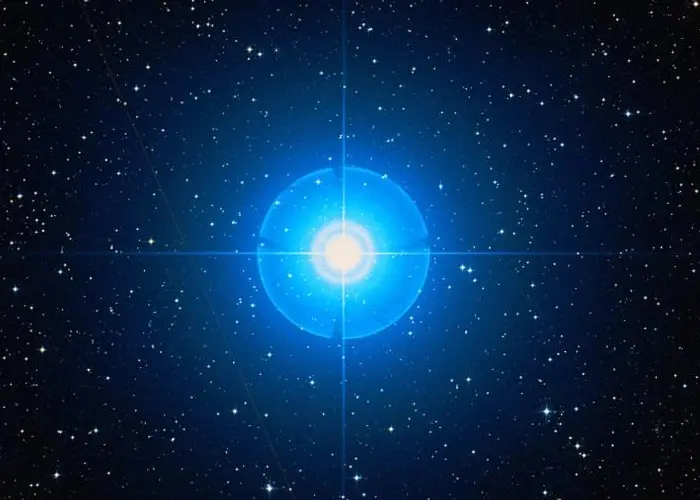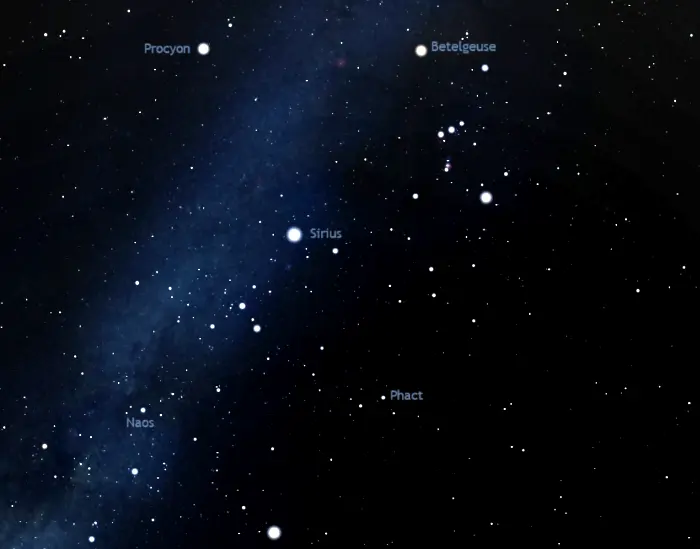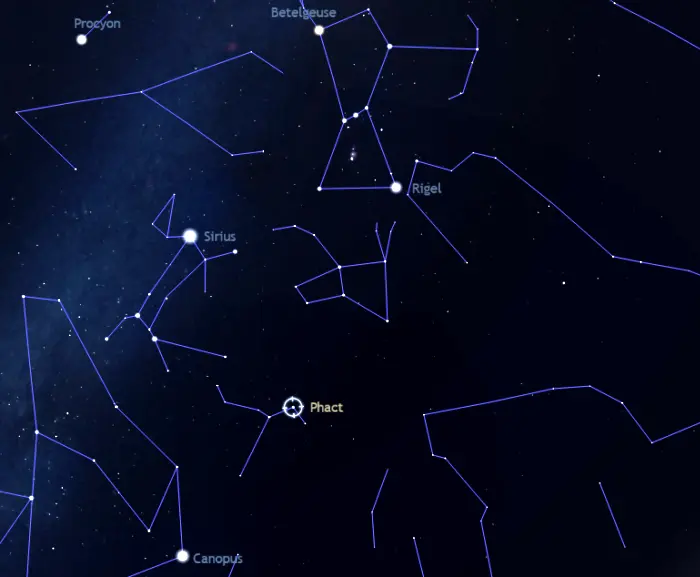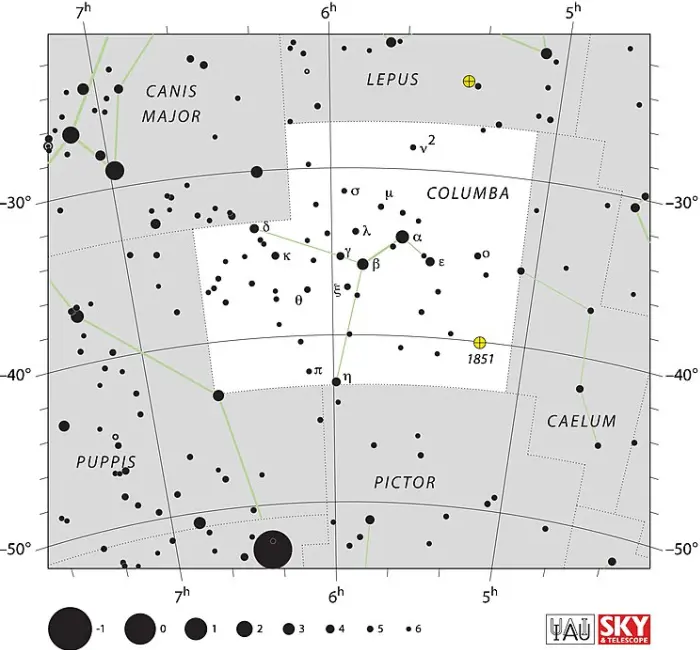Phact, Alpha Columbae (α Col), is a hot blue B-type star located approximately 261 light-years away in the constellation Columba (the Dove). With an apparent magnitude of 2.645, it is the brightest star in Columba. It is part of a large asterism known as the Egyptian X.
Star type
Phact is a hot blue main sequence star of the spectral type B9Ve. It has a mass 4.5 times that of the Sun and a radius 5.8 times the Sun’s. With a surface temperature of 12,963 K, it is 1,000 times more luminous than the Sun.
The star is a fast spinner, with a projected rotational velocity of 176 km/s. It has an estimated age of only 93 million years.
Phact is classified as a Be star, a hot B-type star with emission lines in its spectrum. These lines are believed to come from a circumstellar disk of material expelled from the star as a result of its rapid rotation.

Phact (Alpha Columbae), image: Wikisky (DSS)
Phact is a suspected Gamma Cassiopeiae variable. Gamma Cassiopeiae stars show irregular brightness variations caused by equatorial decretion disks that occasionally reform and disappear. The brightness of Alpha Columbae has been observed to vary between magnitude 2.62 and 2.66. The variations are caused by the hot gaseous disk of ejected material.
Other bright stars in this class include the prototype Gamma Cassiopeiae in the constellation Cassiopeia, Pleione in the Pleiades cluster in Taurus, Dschubba in Scorpius, Gomeisa in Canis Minor, Zeta Ophiuchi in Ophiuchus, and Lambda Pavonis in Pavo.
Alpha Columbae is a single star. It has a faint visual companion at a separation of 13.5 arcseconds. The two stars are catalogued as WDS J05396-3404 in the Washington Double Star Catalog.
Facts
Phact is part of a large asterism known as the Egyptian X. The asterism is formed by the bright stars of the Winter Triangle – Betelgeuse in the constellation Orion, Procyon in Canis Minor, and Sirius in Canis Major – with Phact in Columba and Naos in Puppis. The star pattern consists of two triangles that meet at Sirius. One is the Winter Triangle and the other is the triangle formed by Sirius, Naos and Phact.

Egyptian X, image: Stellarium
In Tahitian mythology, Phact was seen as one of the 10 pillars that hold the sky. The star was called Ana-iwa. The other nine pillars were Antares in the constellation Scorpius, Dubhe in Ursa Major, Aldebaran in Taurus, Arcturus in Boötes, Spica in Virgo, Alphard in Hydra, Polaris in Ursa Minor, Betelgeuse in Orion, and Procyon in Canis Minor.
Name
The name Phact (pronunciation: /ˈfækt/) comes from the Arabic fākhitah, meaning “ring dove.” The name initially applied to the northern constellation Cygnus (the Swan) but was later transferred to Alpha Columbae. It was historically also spelled Phakt, Phad, and Phaet.
The name was approved by the International Astronomical Union’s (IAU) Working Group on Star Names (WGSN) on July 20, 2016.
In Chinese astronomy, Phact was known as 丈人一 (Zhàng Rén yī), the First Star of Grandfather. It formed the Grandfather asterism with the fainter Epsilon Columbae. The asterism was part of the larger Well mansion, one of the southern mansions of the Vermilion Bird.
Location
Phact is very easy to find because it forms an asterism with the bright Sirius, Procyon, Betelgeuse, and Naos. The Egyptian X can be used to identify the star. A line drawn from Procyon through Sirius and extended by about the same distance as that between the two stars leads to Phact. The star lies in the region between Rigel and Canopus, south of the constellation figure of the celestial Hare (Lepus).
At declination -34°, Phact is visible from locations south of the latitude 55° N.

The location of Phact (Alpha Columbae), image: Stellarium
The star can be used to find the bright globular cluster NGC 1851. The cluster lies about 9 degrees to the southwest and can be spotted in binoculars and small telescopes. It has an apparent magnitude of 7.3 and an apparent size of 11 arcminutes. The cluster is listed as Caldwell 73 in the Caldwell catalogue of deep sky objects visible in amateur telescopes. It lies 39,500 light-years away.
Constellation
Phact is located in the southern constellation of Columba (the Dove). Columba is a small and inconspicuous constellation south of the celestial equator. It occupies an area of 270 square degrees and contains only one star brighter than magnitude 3.0 (Phact).
Columba is not one of the ancient constellations. It was created by the Dutch-Flemish astronomer and celestial cartographer Petrus Plancius in the late 16th century. Plancius named the constellation Columba Noachi (Noah’s Dove), but the name was later shortened to Columba. German astronomer Johann Bayer included the constellation in his star atlas Uranometria of 1603.
Notable stars in Columba include the orange giants Wazn (Beta Columbae), Epsilon Columbae, Xi Columbae, and Kappa Columbae, the yellow bright giant Delta Columbae, the giant or bright giant star Eta Columbae, the hot blue subgiants Gamma Columbae and Elkurud (Theta Columbae), and the hot blue runaway star and supernova candidate Mu Columbae. The constellation also hosts AP Columbae, the nearest pre-main sequence star to the Sun. The young star lies 28.264 light-years away.

Columba constellation map, image: IAU and Sky & Telescope magazine (Roger Sinnott & Rick Fienberg) (CC BY 3.0)
Deep sky objects in the constellation include the bright globular cluster NGC 1851, the starburst spiral galaxy NGC 1792, the barred spiral galaxy NGC 1808, and the fossil group giant elliptical galaxy ESO 306-17.
The best time of the year to observe the stars and deep sky objects of Columba is during the month of February, when the constellation appears higher above the horizon in the early evening. The entire constellation can be seen from locations south of the latitude 45° N.
The 10 brightest stars in Columba are Phact (Alpha Col, mag. 2.645), Wazn (Beta Col, mag. 3.105), Delta Columbae (mag. 3.85), Epsilon Columbae (mag. 3.87), Eta Columbae (mag. 3.96), Gamma Columbae (mag. 4.366), Kappa Columbae (mag. 4.37), Omicron Columbae (mag. 4.81), Lambda Columbae (mag. 4.86), and Xi Columbae (mag. 4.97).
Phact – Alpha Columbae
| Spectral class | B9Ve |
| Variable type | Gamma Cassiopeiae (suspected) |
| U-B colour index | −0.44 |
| B-V colour index | −0.125 |
| R-I colour index | −0.09 |
| Apparent magnitude | 2.645 |
| Absolute magnitude | −1.87 |
| Distance | 261 ± 8 light-years (80 ± 2 parsecs) |
| Parallax | 12.48 ± 0.36 mas |
| Radial velocity | +35.0 ± 4 km/s |
| Proper motion | RA: −1.58 ± 0.28 mas/yr |
| Dec.: −24.82 ± 0.50 mas/yr | |
| Mass | 4.5 M☉ |
| Luminosity | 1,000 L☉ |
| Radius | 5.8 R☉ |
| Temperature | 12,963 K |
| Age | 93 million years |
| Rotational velocity | 176 km/s |
| Surface gravity | 3.73 cgs |
| Constellation | Columba |
| Right ascension | 05h 39m 38.9410319s |
| Declination | −34° 04′ 26.794991″ |
| Names and designations | Phact, Alpha Columbae, α Col, HD 37795, HR 1956, HIP 26634, SAO 196059, FK5 215, PPM 281732, GC 7078, GCRV 3510, CD−34 2375, CPD−34 703, NSV 2549, PLX 1303.00, JP11 1225, IRAS 05378-3405, 2MASS J05393893-3404268, Hen 3-8, UBV 5798, TYC 7064-1357-1, Gaia DR3 2900546759663847168, IDS 05360-3408 A, CCDM J05396−3404 A, WDS J05396-3404A |